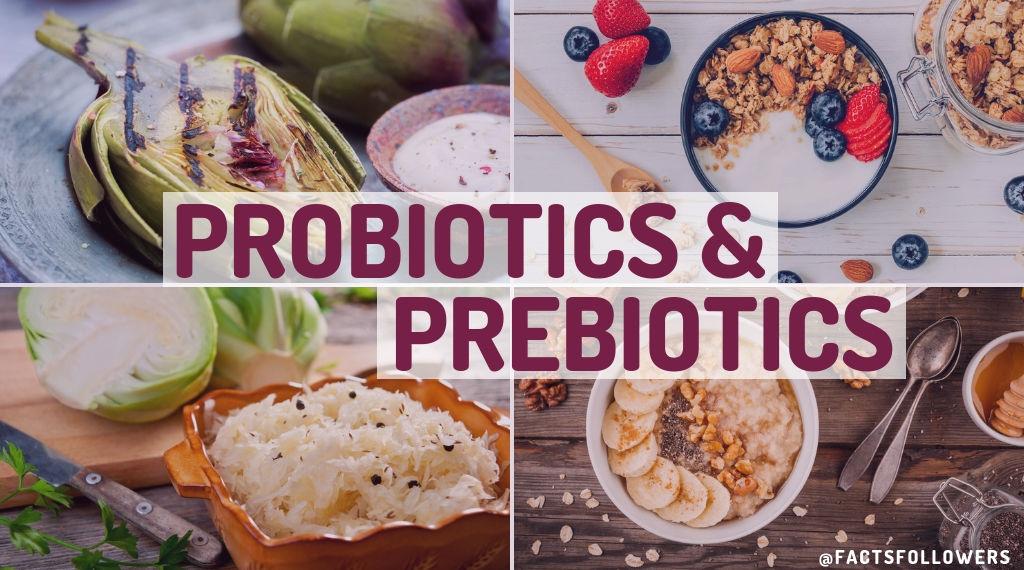We hear so much about eating to improve our “gut health.” These conversations almost always involve a discussion about foods that contain prebiotics and probiotics. But what exactly are they? Where can we find them? And do they really benefit our health? Read on for the details.
The World Health Organization defines probiotics as, “live microorganisms that, when administered in adequate amounts, confer a health benefit on the host.” The premise is that consuming probiotics will enhance or restore balance to our gut microbiome, which are the microbes that inhabit our gastrointestinal tracts. Probiotic bacteria are necessary for the fermentation of milk into yogurt and kefir. They’re also responsible for transforming vegetables into foods like kimchi and sauerkraut. During fermentation, bacteria or yeasts convert the starches and sugars found in foods into alcohol or acids.
As their popularity grows, probiotics are being added to all kinds of food and drinks. Probiotic-containing products will mention them on food packaging with the phrase “contains live and active cultures.” The product label will also list specific types of bacteria in the ingredients list.
The technical definition of prebiotics is “a substrate that is selectively utilized by host microorganisms conferring a health benefit.” In simpler terms, we can think of them as substances in foods that can’t be broken down by human digestive enzymes. Instead, prebiotics travel to our lower gastrointestinal tract where they’re fermented by probiotic bacteria. In a nutshell, probiotics are microorganisms that are beneficial for our health, and prebiotics are what feed probiotics. Fruit, vegetables, cereals and other edible plants all have potential to provide prebiotics. Artichokes, asparagus, bananas, berries, chicory, garlic, green vegetables, legumes (like peas and beans), onions, tomatoes, oats, barley and wheat are among the sources of naturally occurring prebiotic fiber. If you’re a food label reader, you might have noticed a few items on the ingredients list like lactulose, inulin and oligosaccharides, which are also classified as prebiotic. They are sometimes called “isolated” or “synthetic” fibers because they’re added to foods like granola bars, cereal, and yogurt to boost their nutrition content and aren’t intrinsically present in the original product.
As we continue to learn more about how our gut health affects our overall well-being, it’s clear that prebiotics and probiotics are important players in the game. It’s also evident that much more research is needed. Here are a few things to keep in mind:
- It’s thought that many probiotic strains are transient citizens of the gastrointestinal tract, making an appearance after we eat, drink or swallow them and then going on their way. Maintaining a continual presence of these probiotic microbes may require repeatedly re-introducing them – for example, by taking several probiotic capsules per day or making yogurt part of your daily eating pattern.
- We don’t yet know what the “ideal” amount of daily prebiotic or probiotic intake is, and there’s no map of exactly which strains of probiotic bacteria use which kinds of prebiotics. This makes it difficult to selectively enhance the presence of different types of beneficial bacteria, which may turn out to be an important factor for our health.
- There are many different strains of probiotics, and research studies often evaluate just one of them or a mix of a few. This means that the results of one study can’t be applied to the probiotics category as a whole.
- Most prebiotic and probiotic studies are small and use different doses and delivery methods (dietary supplement versus food, for example).
- It’s unclear if some products that promote their probiotic content actually deliver on that claim. Many strains of bacteria are killed off by high temperatures and processes like pasteurization, which is a crucial step for food safety. In short, we’re a long ways off from making sense of how – or if – probiotics impact the health of most people.
- Probiotics may not be safe for people with severely suppressed immune systems, such as those who are critically ill, people with HIV/AIDS, those who have received an organ transplant and people who are undergoing chemotherapy for cancer treatment.
While we wait for more answers, it won’t hurt to get a jump-start on bumping up your prebiotic and probiotic intake. Doing so might pack a one-two nutritional punch, since they’re found in foods that are healthy for a variety of reasons beyond gut health.
To read more about prebiotics, probiotics and other foods that impact our gut microbiome, take a look at our Gut Check series.
This blog was written by Casey Evans, 2018 Sylvia Rowe fellow, and includes contributions from Allison Webster, PhD, RD.

